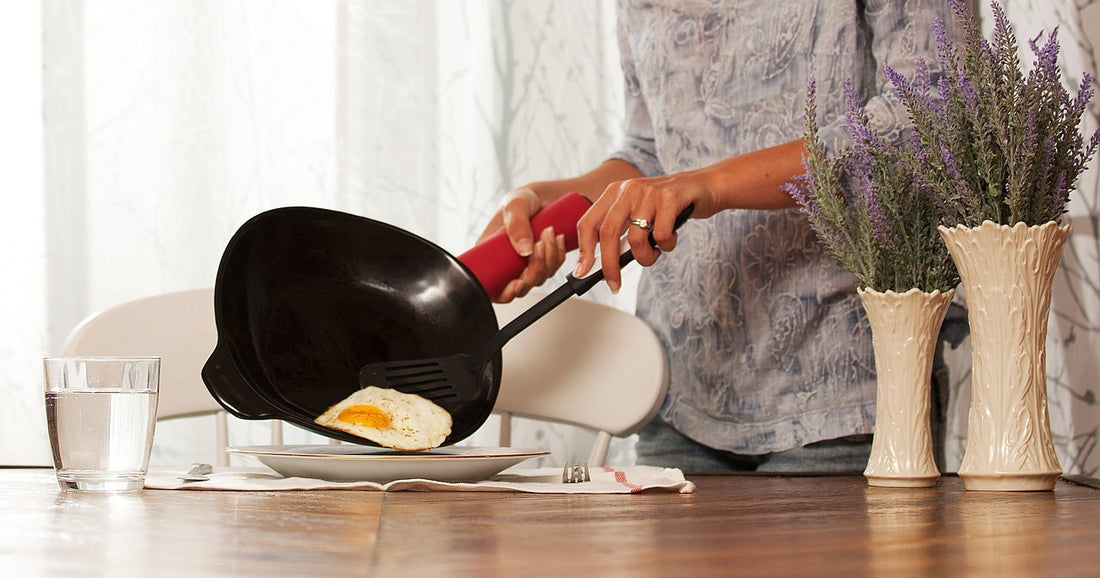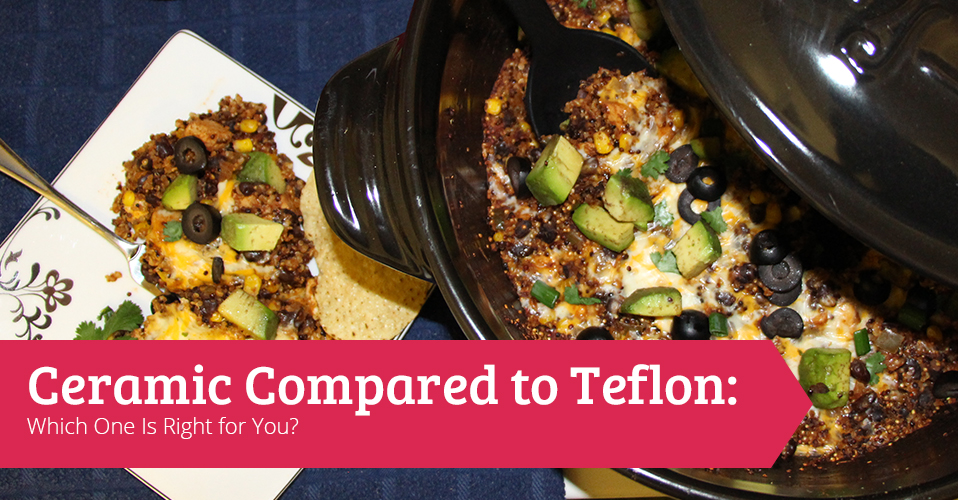
Whether you’re a foodie or just someone who’s interested in cooking good, healthy meals for you and your family, you might be confused by all the cookware options out there. Walk into almost any store and you’ll find an array of pots and pans made from aluminum, stainless steel, Teflon, ceramics and other materials. How can you choose the best, non-toxic, non-stick cookware for your cooking needs? Which cookware and bakeware options are safest? Which ones deliver the performance you deserve?
Two of the most popular choices today are Teflon and Ceramic. Teflon pots and pans are engineered from man-made metal, polymer/plastic materials and other chemicals while boasting a non-stick cooking surface. They are popular because they are very inexpensive and the manufacturer promises that the cooking surface will provide for an easy clean-up.
Ceramic cookware is made from all-natural inorganic non-toxic materials and is designed to be 100% non-scratch. 100% ceramic pots and pans are popular because they contain no metals, lead, cadmium, plastics or chemical of any kind. Ceramic cookware is both attractive and extremely versatile.
So which are right for you?
Is Teflon Cookware Safe?
Teflon is the brand name of a non-stick finish or coating (known as polytetrafluoroethylene or PTFE) used on pots, pans and other products. It’s made by the DuPont Company. Pans and pots coated with this material are non-stick, which can be attractive for cooks who don’t want to worry about burning their food.
However, there are many safety concerns regarding Teflon and other non-stick coatings. The biggest problem? Teflon doesn’t always stand up well to heat, and heating is exactly what you’re going to do with your cookware. At high temperatures, Teflon emits toxic fumes. The maximum temperature you can use with Teflon cookware is 500°, but some cookware includes handles or parts can only withstand temperatures of 350°. At 689°, Teflon emits six toxic gases, including two carcinogenic (cancer-causing) gases, according to some studies.
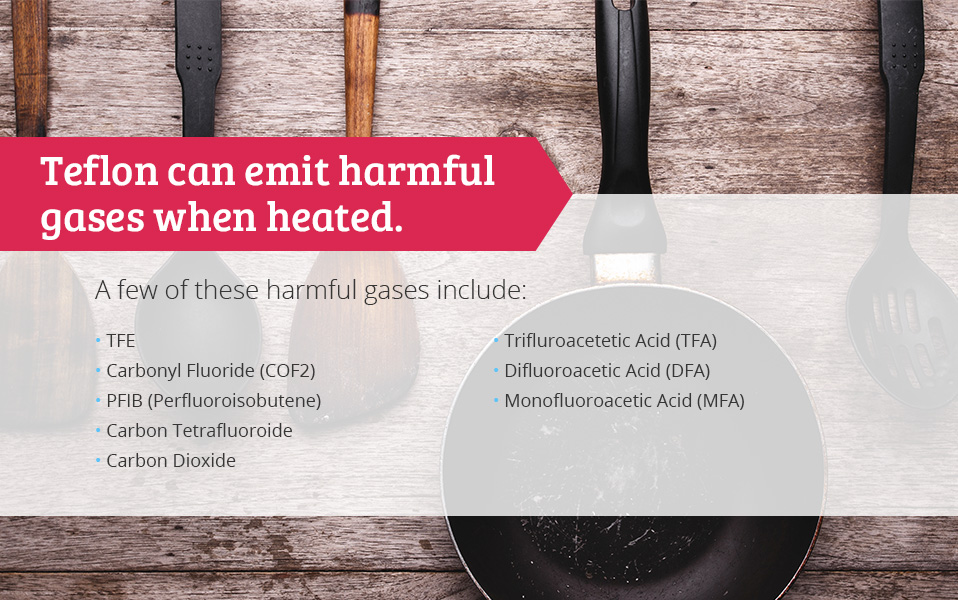
Even DuPont suggests you should never heat your Teflon-coated pots and pans above medium heat — but what happens if a recipe calls for high heat? The makers of Teflon have a high number of recommendations for cooking with Teflon cookware. For example, they recommend only using low or medium heat and never heating an empty pan. The makers of Teflon claim these precautions are so the cookware lasts longer, but many consumers are concerned. The reality is Teflon can emit many harmful gases when heated, among them:
- TFE
- HFP
- Carbonyl fluoride (COF2)
- PFIB (Perfluoroisobutene)
- Carbon tetrafluoride
- Carbon dioxide
- Trifluoroacetetic acid (TFA)
- Difluoroacetic acid (DFA)
- Monofluoroacetic acid (MFA)
Some of these are used in chemical warfare agents and in pesticides — not exactly what you want to be serving with brunch. Sure, you can avoid some of the off-gassing by keeping the heat under your Teflon pan low. But you may be surprised at just how quickly Teflon cookware can overheat.
A study by the Environmental Working Group found Teflon can release toxic gases after only two minutes on a conventional stovetop. And since different stovetops in different homes can heat differently, it can be hard to figure out just what levels are “safe.” How can you know when your pan enters that “danger” territory unless you’ve got a thermometer on the pan at all times?
The American Cancer Society claims Teflon isn’t suspected of causing cancer, but they do state the materials used in the making of Teflon are potentially dangerous. They also note the fumes which are emitted by overheated Teflon can cause “polymer fume fever,” which leads to flu-like symptoms and can be fatal for birds.
If you can’t use a pan safely in your home without killing a bird, do you really want to be serving food made on the pan to your family?
It may get worse. Teflon is made using petroleum-based perfluorooctanoic acid and polytetrafluoroethylene. Small bits of Teflon will flake off during cooking and end up in your food, meaning you’re swallowing the non-stick coating in very small amounts. DuPont has claimed eating these tiny amounts of Teflon is safe, but do you really want to be eating these man-made chemicals with your omelets or pasta?
And keep in mind, once the pan’s coating is compromised, it can create an uneven surface or even tiny holes in the surface of the pan or pot. This can be a problem since bacteria and food can lurk in these uneven spaces.
Is Ceramic Cookware Safe?
Ceramic cookware safety is acknowledged as safe by many scientists, in part because of what ceramic cookware doesn’t have. Ceramic pots and pans are free from metals and perfluorooctanoic acid (PFOA), a toxic material used in the Teflon manufacturing process. Ceramic bakeware and cookware is simply not manufactured using this material — or other toxic chemicals.
Xtrema ceramic pots and pans are made from an all-natural ceramic, and Xtrema cookware can withstand temperatures of over 2500° F with no toxic fumes, no melting, no damage and no warping. If you’re looking for Teflon cookware alternatives and want pots, pans and bakeware that will stand up to all your recipes and cooking demands, ceramic is extremely durable. Xtrema ceramic cookware does not flake off or melt off at any temperature, so it does not enter your food. When you cook with ceramic cookware, you’re eating your food and only your food — not the pan it was made in.
Xtrema cookware also has a 100% natural bacteria-resistant ceramic glaze. This ensures your food’s safety and also keeps foods, especially acidic ones, from leaching into the surface of the cookware. Thanks to this bacteria-resistant product, you don’t have to worry about the taste of one food transferring into the taste of your next dish.
If Ceramic Cookware’s Safe, What’s Clean-Up Like?
Makers of Teflon and other non-stick surfaces claim Teflon is low-maintenance. Pots and pans coated with the material can be easily washed, and since food doesn’t stick to the surface, there’s usually no soaking required. Most Teflon cookware can be washed in the sink with a mild detergent and a sponge.
Well, there’s good news for those who like the thought of safe ceramic cookware. Quality ceramic pots and pans, like the Xtrema product line, are just as easy to clean. All you need to remember is to use wood, silicone or plastic utensils with your cookware. Xtrema cookware is designed with a non-scratch ceramic glaze, so it’s meant to last a long time. Using the right utensils helps it last even longer. Because Xtrema ceramic cookware withstands high temperatures, it can even be popped into the dishwasher if need be.
Flexibility and Your Cookware
Teflon is non-stick, so can be used with your stickiest, gooiest dishes (as long as your recipe doesn’t call for high heat). When it comes to flexibility, though, Xtrema ceramic cookware is the clear winner. Since Xtrema cookware can withstand very high temperatures without melting, it’s flexible enough to be used under the broiler, in the oven, on the grill, on the stovetop and even in the microwave — something Teflon can’t do.
And while Teflon isn’t made for looks, Xtrema ceramic cookware is attractive enough to go from the oven to the table. The colors and attractive glaze on Xtrema ceramic bakeware and cookware make it great as serving containers, too.
And storing leftovers with Xtrema ceramic cookware and bakeware couldn’t be easier. These pots and pans go from the oven or the stove to the table or the fridge. Just pop the ceramic cover on top of your dish, and put it in the fridge for the next day. Teflon just doesn’t handle extreme temperature changes as well.
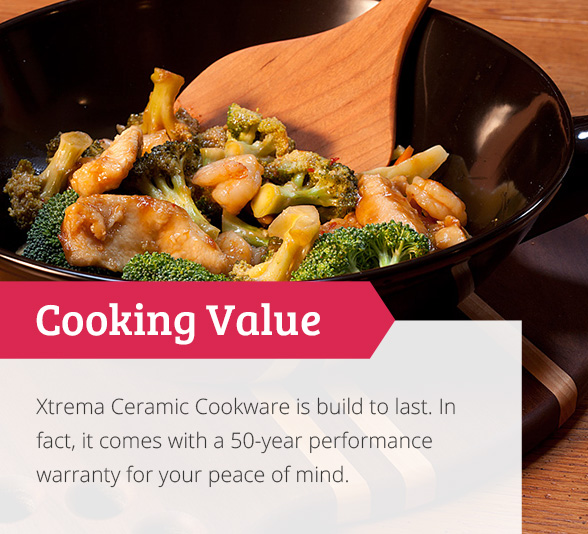
Looking for Cookware Value?
Teflon pots and pans will need to be replaced. If you’ve ever had Teflon cookware, you know the plastic non-stick coating wears away eventually, and you need to replace the item. This is because of what is known as heat-based decay (pyrolysis). Basically, high heat will eventually erode the coating, and the process can be hastened if you cook highly-acidic foods, since they can break down the coating even faster.
Xtrema ceramic cookware, on the other hand, is built to last. In fact, it comes with a 50-year performance warranty against thermal breakage for your peace of mind. With just a little care, your ceramic cookware can keep looking great for years. And since the cooking surface is made of non-scratch ceramic, you never have to worry about any coating warping, melting or flaking off. All it takes is a little care to avoid chipping, and you’ll have your Xtrema pots and pans looking their best for years to come.
Green Cookware
Of course, you want to be able to cook food safely, but you’re probably also aware of the environmental impact of your buying decisions. If you’re looking for non-toxic, non-stick pans and are considering your Teflon and ceramic choices, keep this in mind: Xtrema ceramic cookware is made from 100% natural ceramics, not man-made materials responsible for creating extra pollution in the manufacturing process. It’s also handmade for a gentler manufacturing procedure.
There have been some concerns raised about the Teflon manufacturing process because perfluorooctanoic acid (PFOA), a possible cancer-causing chemical, is used.
During Teflon manufacturing, PFOA may be released into the atmosphere, and some have argued traces of it may remain in Teflon pots and pans. In fact, the makers of Teflon have reached an agreement with the Environmental Protection Agency (EPA) to phase out the use of PFOA in the manufacturing process.
Most experts — including the American Cancer Society — however, agree Teflon pans and pots likely don’t contain PFOA since the material is burned away during the manufacturing process.
Despite this, if you consider buying Teflon, you might want to know the cookware is made using this material, and it may have an impact on the environment. PFOA does not break down easily and remains in the body. If it leaks into the surrounding area, it can have an impact on local ecology. In 2004, DuPont reached a $343 million settlement after being accused of polluting drinking water near a Teflon manufacturing facility.
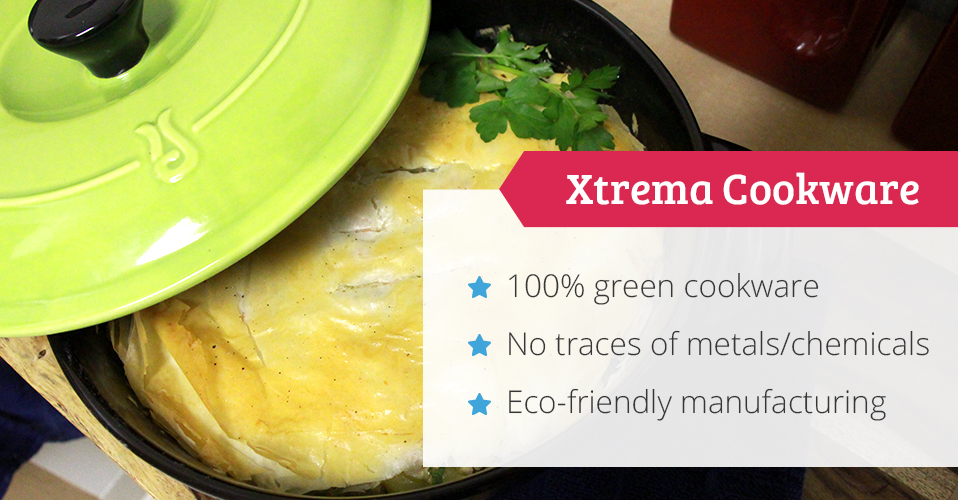
When considering the environmental impact of your pots and pans, you’ll want to consider energy usage, too. Teflon-coated pans and pots heat up fast, but the pan or pot stays hotter than the food you’re cooking. You’ll have to turn the pan up higher to get your food hotter — and we’ve already talked about what happens when you turn the heat high on under your non-stick pan.
Ceramic pots and pans, on the other hand, naturally retain heat more efficiently. It takes less energy to heat your food, and food stays hotter longer, which may be important in preventing food-borne illnesses. Food heats evenly thanks to the cookware’s natural thermal conductivity, giving you more control over your cooking and ensuring your food is cooked correctly all the way through.
Before you buy a non-toxic, non-stick pan, you’ll also want to consider its lifespan and what will happen once you need to toss your pan. If you buy Teflon and toss your cookware into the trash once the coating has worn off, the PTFE remaining in the pan can harm birds when the cookware ends up at a landfill.
Ceramic is an inert material and a natural product, so it may be less harmful. It will not emit fumes, even if does end up in a landfill. And since Xtrema ceramic cookware can last for many years, you’ll also be tossing less of your cookware away, which’ll save you money and also prove to be gentler on the environment.
What’s the Bottom Line?
If you’re looking at ceramic cookware compared to Teflon and wondering which one is right for you, you may want to consider the excellent record of ceramic cookware safety and the durability of the product. A quality, safe ceramic cookware or bakeware line like Xtrema can give you years of hassle-free cooking — all without you having to worry about toxic fumes, chemicals or unwanted flavors transferring into your food.
Since Xtrema ceramic cookware also resists bacteria, you don’t have to worry about particles of food or traces of taste from your last meal lurking in the corners of your pots and pans. If you’ve ever had pancakes that taste faintly of last night’s dinner, you’ll appreciate that when you cook with Xtrema ceramic cookware, the true taste of your favorite dishes shines through each time.
And if you care about the environment, you can rest assured that Xtrema is 100% green cookware. Made from a natural mineral and manufactured without PFOA and other toxins the EPA is banning, Xtrema ceramic bakeware and cookware lets you enjoy healthy meals. No traces of metals or chemicals will leach from your bakeware into your recipes, and our handcrafted pots and pans are made with an eco-friendly manufacturing process.
Xtrema cookware is great to use, whether you’re a foodie or a novice. If you’re a serious cook, you’ll love Xtrema cookware, which is safe for the oven, broiler, barbecue grill, dishwasher, stovetop, freezer or fridge. You can use it with your most demanding recipes and get superb results.
If you’re new to cooking, you’ll love the versatility. You won’t need to get separate pots and pans for everything you want to try; Xtrema ceramic bakeware and cookware will work well with any food you attempt.
Take a look at the Xtrema product line today and start dreaming up the healthy, delicious foods you could serve in your kitchen.
